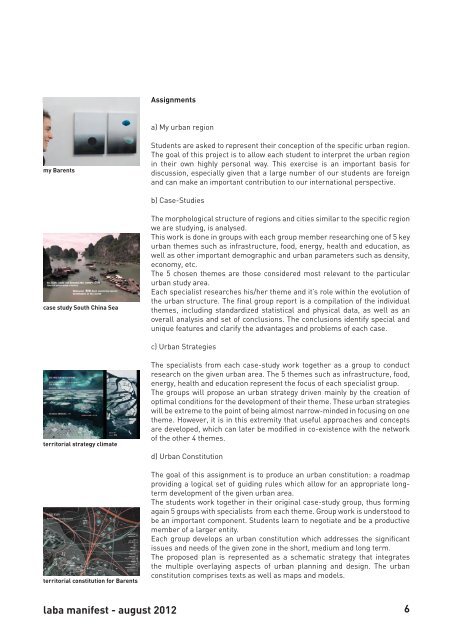Research - LABA - EPFL
Research - LABA - EPFL
Research - LABA - EPFL
You also want an ePaper? Increase the reach of your titles
YUMPU automatically turns print PDFs into web optimized ePapers that Google loves.
PAINTINGS<br />
by Pauline Seigneur<br />
PAINTINGS<br />
by Pauline INSTALLATION<br />
Seigneur<br />
by Elsa Beniada<br />
my Barents<br />
case study South China Sea<br />
territorial strategy climate<br />
territorial constitution for Barents<br />
Assignments<br />
laba manifest - august 2012<br />
a) My urban region<br />
Students are asked to represent their conception of the specific urban region.<br />
The goal of this project is to allow each student to interpret the urban region<br />
in their own highly personal way. This exercise is an important basis for<br />
discussion, especially given that a large number of our students are foreign<br />
and can make an important contribution to our international perspective.<br />
b) Case-Studies<br />
The morphological structure of regions and cities similar to the specific region<br />
we are studying, is analysed.<br />
This work is done in groups with each group member researching one of 5 key<br />
urban themes such as infrastructure, food, energy, health and education, as<br />
well as other important demographic and urban parameters such as density,<br />
economy, etc.<br />
The 5 chosen themes are those considered most relevant to the particular<br />
urban study area.<br />
Each specialist researches his/her theme and it’s role within the evolution of<br />
the urban structure. The final group report is a compilation of the individual<br />
themes, including standardized statistical and physical data, as well as an<br />
overall analysis and set of conclusions. The conclusions identify special and<br />
unique features and clarify the advantages and problems of each case.<br />
c) Urban Strategies<br />
The specialists from each case-study work together as a group to conduct<br />
research on the given urban area. The 5 themes such as infrastructure, food,<br />
energy, health and education represent the focus of each specialist group.<br />
The groups will propose an urban strategy driven mainly by the creation of<br />
optimal conditions for the development of their theme. These urban strategies<br />
will be extreme to the point of being almost narrow-minded in focusing on one<br />
theme. However, it is in this extremity that useful approaches and concepts<br />
are developed, which can later be modified in co-existence with the network<br />
of the other 4 themes.<br />
d) Urban Constitution<br />
The goal of this assignment is to produce an urban constitution: a roadmap<br />
providing a logical set of guiding rules which allow for an appropriate longterm<br />
development of the given urban area.<br />
The students work together in their original case-study group, thus forming<br />
again 5 groups with specialists from each theme. Group work is understood to<br />
be an important component. Students learn to negotiate and be a productive<br />
member of a larger entity.<br />
Each group develops an urban constitution which addresses the significant<br />
issues and needs of the given zone in the short, medium and long term.<br />
The proposed plan is represented as a schematic strategy that integrates<br />
the multiple overlaying aspects of urban planning and design. The urban<br />
constitution comprises texts as well as maps and models.<br />
6



